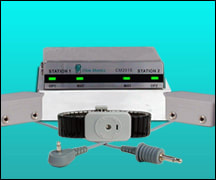ESD Problem Solving
Electrostatic discharge (ESD) is a real issue just about everyone deals with. Whether it comes from grabbing a door handle or shaking hands with someone, this jump of electricity occurs everywhere. However, it is important that ESD does not occur in certain places, especially in areas heavy on electronics and materials susceptible to such a charge. Any small amount of electricity sent through one of these devices can short out and completely destroy tens of thousands of dollars worth of equipment instantly. So, whether you run a small computer operation or a multi-million dollar corporation, you need to know how to perform proper ESD problem solving. This ensures you avoid ESD and correct it on the spot.
Grounding and Removing Problems
 When working on electronic devices, you first need to make sure you are properly grounded. There are different ways to do this, but personal grounding devices are helpful. Some devices come in the form of a ankle/shoe sling. This device attaches around the heel of a shoe and has a small metal connector. The metal connector, when combined with a ground metal piece on the floor, removes any electrostatic charge. This works well if you are walking through a room and need to clear a possible charge. When working with computers you might wear a wrist-based personal ESD grounding device. These devices have a small metal clip that snaps into a ground point. Some of them come with a clamp that attaches to a screw on the computer, while others come with a grounding mat that features a metal snap to attach the personal grounding device to. Either way, to reduce the risk of ESD, grounding is a must.
When working on electronic devices, you first need to make sure you are properly grounded. There are different ways to do this, but personal grounding devices are helpful. Some devices come in the form of a ankle/shoe sling. This device attaches around the heel of a shoe and has a small metal connector. The metal connector, when combined with a ground metal piece on the floor, removes any electrostatic charge. This works well if you are walking through a room and need to clear a possible charge. When working with computers you might wear a wrist-based personal ESD grounding device. These devices have a small metal clip that snaps into a ground point. Some of them come with a clamp that attaches to a screw on the computer, while others come with a grounding mat that features a metal snap to attach the personal grounding device to. Either way, to reduce the risk of ESD, grounding is a must.
If you find that a particular area always seems to have ESD you need consider its layout carefully. When possible necessary, disconnect any cables running and out of the device to eliminate as much risk as possible. This not only reduces electrical currents running between devices, but it prevents an electrical surge into other hardware should an ESD occur. Your ESD problem solving should include removing jewelry and any other potentially problematic items from yourself as well.
Reduce ESD Creating Objects
In order to reduce ESD, it is necessary to reduce the potential creation of ESD. If you or another individual is constantly being shocked, the likely culprit is clothing. Electrostatic currents develop from friction, which is caused by pant legs moving together, feet going over carpet, hands running through hair and so on. ESD problem solving begins with removing articles of clothing that creates ESD, or wearing protective clothing over this. ESD clothing such as jackets, coats, shirts and gloves reduces friction, which reduces the creation of ESD. In order to perform ESD problem solving, it is necessary to reduce as many potential culprits as possible. With the proper clothing, this eliminates the creation of an electrostatic charge and makes identifying other problem areas easier.
Flooring
 After changing clothing and wearing the proper protective attire, if ESD still occurs, the next step is to bring in proper flooring. Carpet is a major culprit when it comes to the creation of an electrostatic current. While stone and wood flooring can reduce static production, it is not 100 percent safe. That is why an ESD flooring is needed. The flooring comes in two different materials: rubber and vinyl. Depending on your particular needs and what equipment you work with, varying thickness levels are available as well. With these kinds of flooring options, you remove another ESD variable.
After changing clothing and wearing the proper protective attire, if ESD still occurs, the next step is to bring in proper flooring. Carpet is a major culprit when it comes to the creation of an electrostatic current. While stone and wood flooring can reduce static production, it is not 100 percent safe. That is why an ESD flooring is needed. The flooring comes in two different materials: rubber and vinyl. Depending on your particular needs and what equipment you work with, varying thickness levels are available as well. With these kinds of flooring options, you remove another ESD variable.
Detection
If your room still suffers from occasional ESD you need to identify where this charge is coming from. It is possible someone simply is not completely protected from static discharge, or a particular outlet or device may have a faulty seal around a wire, which can lead to the creation of electrostatic currents in the room or device itself. A handful of different hand-held ESD readers makes it possible to locate a possible current and its current strength. Having such a device in the room you wish to protect is a valuable opportunity. This makes ESD problem solving easier than ever. With the device, you can move about the room to see where the current is coming from. Once you identify the source of your current, you can then go about and correct the problem.
ESD problem solving is a must when working with electrostatic sensitive devices. These devices come in many shapes and forms, ranging from microchips to chemicals. Whatever it is, if you are currently experiencing ESD problems, you need to know how to troubleshoot and identify the electrostatic current source before it becomes a major problem.
